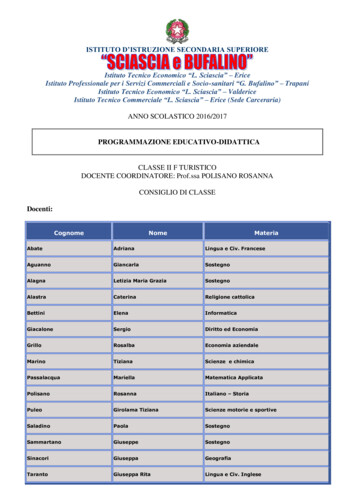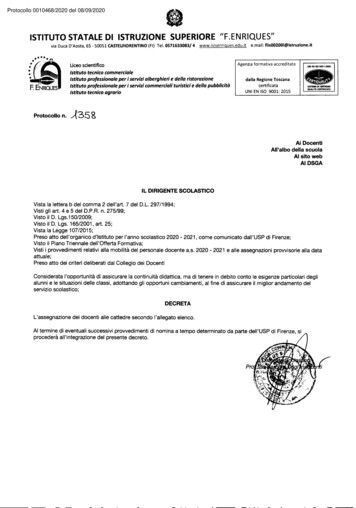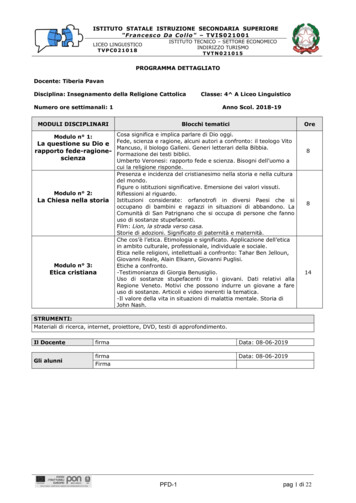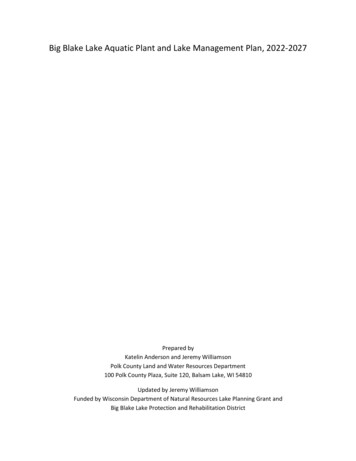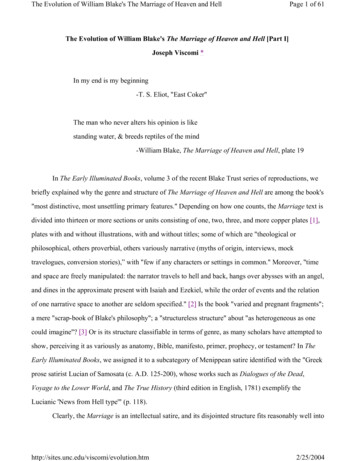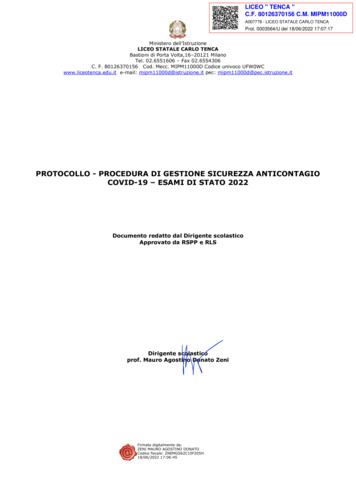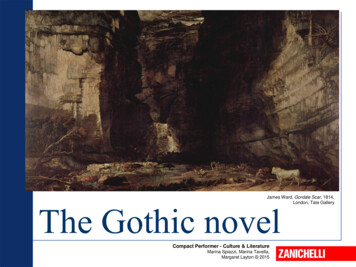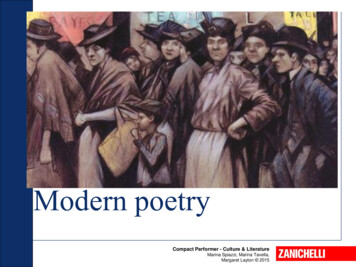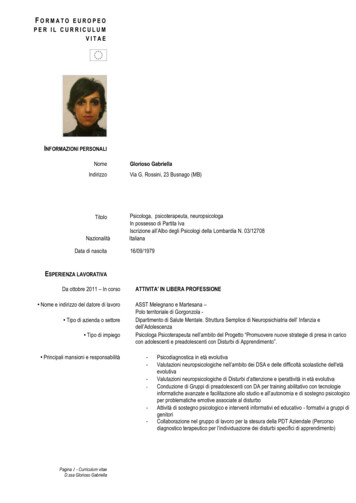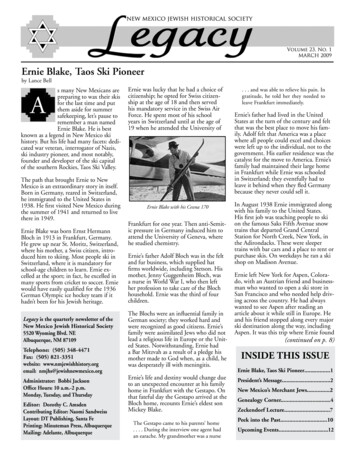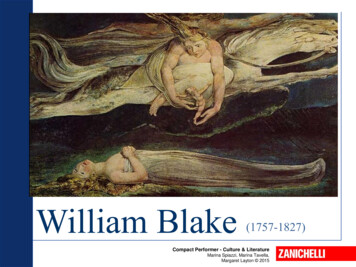
Transcription
William Blake(1757-1827)Compact Performer - Culture & LiteratureMarina Spiazzi, Marina Tavella,Margaret Layton 2015
William Blake (1757-1827)1. Life Born into a family of humble origin in 1757. Trained as an engraver, he practised this craft until he died. He was a poet, painter and engraver and illustrated his ownpoetical works. Was deeply aware of the great political and social issues ofhis age. He criticized the evil consequences of the IndustrialRevolution. He supported the abolition of slavery. He supported theFrench Revolution and remained a radical throughout his life. Hejustified even the period of Terror as a necessary evil for theprogress of humanity. He had a strong sense of religion: the most important literary influence in his lifewas the Bible. He illustrated many works that had to do with religion: the Bible,Dante’s Divine Comedy, Milton’s Paradise Lost. He claimed he had visions.Died in 1827.Compact Performer - Culture & Literature
William Blake (1757-1827)2. Blake the artist He attended a drawing school since he was10. Studied the works of Raphael andMichelangelo from the latter he learnt thetechnique of representing exaggeratedmuscular bodies. Later he studied at the Royal Academy ofArt. He didn’t conform to standards of realisticrepresentation but emphasized the power ofimagination in art.Compact Performer - Culture & LiteratureWilliam Blake,Vision of the Daughtersof Albion, 1793, London, Tate Gallery
William Blake (1757-1827)2. Blake the artist Connected visual arts and writing,creating ‘illuminated printing’, acombination of picture and poetic text. Also made many illustrations for otherauthors’ works, such as Milton’sParadise Lost or Dante’s DivineComedy.William Blake, Blossom, 1789Compact Performer - Culture & Literature
William Blake (1757-1827)3. Blake the poetAn individual poet, original for his personal vision andtechnique. He is regarded as early Romantic becausehe rejected the Neoclassical style and themes.According to him, the poet becomes a sort of prophetwho can see more deeply into reality.He stressed the importance of imagination overreason. It is through imagination that man can know theworld.Used symbols as part of a deliberate attempt to avoidany kind of realism it is the ‘real’ world that prevents man fromperceiving the greater Reality that lies behind him.Compact Performer - Culture & Literature
William Blake (1757-1827)3. Blake the poet He wrote two collections of poems: Songs ofInnocence (1789) and Songs of Experience(1794). Songs of Innocence deals with childhood asthe symbol of innocence. The language issimple and musical. The poems celebrate thepresence of the divine in all creation. Songs of Experience is more complex andpessimistic. It was written during the period ofterror in the French Revolution.The poems pair those of Songs of Innocence,questioning the themes of the first collection.Cover engraving from the 1826 edition of Songsof Innocence and of ExperienceCompact Performer - Culture & Literature
William Blake (1757-1827)3. Blake the poet The world of innocence is full of joy and happiness, while the world ofexperience is full of cruelty and injustice.However, childhood and adulthood (innocence and experience) arenot considered real opposites but they are complementary, becausethey complete each other.Compact Performer - Culture & Literature
William Blake (1757-1827)4. Blake the prophet Blake wrote also some prophetic books (The Marriage ofHeaven and Hell is the most famous), in which he created hisown symbolic characters. In The Marriage of Heaven and Hell Satan and Hell representliberty and energy, while Heaven is authoritarian. These books express Blake’s own personal Romantic andrevolutionary beliefs. He attacked the repression of humanenergy by conventions. They were published as printed sheets from engraved platescontaining prose, poetry and illustrations. The plates werethen coloured by Blake himself.Compact Performer - Culture & Literature
William Blake (1757-1827)5. Complementary oppositesBlake believed in the existence of a spiritual world but he thought thatChristianity was responsible for the fragmentation of consciousness and thedualism characterising man’s life.In contrast to this dualistic view, he had a vision made up of complementaryopposites. Good and Evil, in particular, are opposite forces but they are alsocomplementary: they are present in the same person or situation.Both in his painting and in his poetry Blake points out that in every aspect ofhuman life there is a dialectical opposition of forces, that can never bereconciled but must co-exist in eternal balance.‘Good and evil, male and female,reason and imagination, cruelty andkindness’The possibility of progress is situated in the tension between contraries.Compact Performer - Culture & Literature
William Blake (1757-1827)6. Blake’s styleBlake’s language and syntax are simple. He often adopts anapparently naive style, using a plain, Anglo-Saxon vocabulary,as well as repetitions, refrains and regular stress patterns whichare typical of ballads and children’s songs and hymns.He also created his own system of symbols.Compact Performer - Culture & Literature
William Blake (1757-1827)7. Blake the artistThe Elohim CreatingAdam 1795. Colourprint finished in penand watercolour. TheTate Gallery, London.Compact Performer - Culture & Literature
William Blake (1757-1827)The picture is framed by a disk of a setting sun and its blazing rays.God is represented with flowing hair and beard, powerful musclesand wings. One hand is on Adam’s head.Adam is beneath God’s weight. He appears in agony and is liftingone arm in supplication. Around his leg there is a snake and one ofhis feet is a hoof.Compact Performer - Culture & Literature
William Blake (1757-1827)7. Blake the artistThe Ancient of DaysThe colours are bright and God isrepresented in an unusual position.He’s kneeling and is holding acompass in his hand. He’s got long,flowing white hair and beard. In thebackground there is a shining sun setagainst a dark, stormy night. Godseems to be measuring the universe.William Blake, The Ancient of Days, 1794EtchingCompact Performer - Culture & Literature
William Blake (1757-1827)Blake gives a very original interpretation of the act of creation.In The Ancient of Days, God’s action of measuring the sky meansthe act of creation, and the clouds and the rays of light that startfrom Him are symbols of the Divine act. The light is the symbol ofenergy and divine power.In Elohim Creating Adam creation appears to be a very dramaticmoment: God seems to fight against evil (the snake, Adam’s footrepresented as a hoof) in order to pass his energy to man.Compact Performer - Culture & Literature
William Blake (1757-1827)7. Blake the artistThe Whirlwind of LoversThe subject is taken fromDante’s Commedia: there ispathos and a dramaticrepresentation of the deadsouls.William Blake, The Whirlwind ofLovers, 1824-1826Compact Performer - Culture & LiteratureThe colours are duller anddarker than those of theprevious picture, and thedynamism of the painting is nolonger positive and lively, butpitiful and sad.
William Blake (1757-1827)7. Blake the artistBlake’s style in the two pictures is allegorical; he mainlyemploys curved lines in order to create a dynamic andactive sensation.William Blake, The Whirlwind ofLovers, 1824-1826Compact Performer - Culture & LiteratureWilliam Blake, The Ancient ofDays, 1794
William Blake (1757-1827)8. LondonRegular rhyme scheme; many repetitions (key-words are often repeated).Many references to sense impressions: “marks”(sight), “I hear”(hearing).Theme: the causes of man’s lack of freedom.Blake criticizes many aspects of his contemporary society, and many socialproblems brought about by the Industrial Revolution:A society where everything is economically exploited (“chartered” , first stanza)and where interest and profit prevail over feelings.Important metaphor: “mind-forged manacles”, line 8 (limitation of freedom)three victims: the chimney-sweeper, the soldier and the prostitute.Criticism to some important institutions: the Church, the Government.Even marriage and the family are threatened by an immoral society (referenceto syphilis that was transmitted from prostitutes, to men and to their wives).Compact Performer - Culture & Literature
William Blake (1757-1827) William Blake, The Ancient of Days, 1794 Etching 7. Blake the artist The Ancient of Days The colours are bright and God is represented in an unusual position. He's kneeling and is holding a compass in his hand. He's got long, flowing white hair and beard. In the background there is a shining sun set
